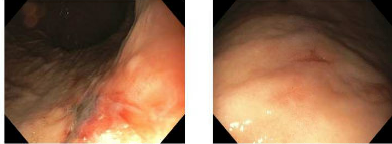Sunday Poster Session
Category: GI Bleeding
P1016 - Beyond the Skin: A Rare Case of Diffuse Upper Gastrointestinal Tract Involvement in Stevens-Johnson Syndrome (SJS)
Sunday, October 26, 2025
3:30 PM - 7:00 PM PDT
Location: Exhibit Hall
- HH
Hubaib Haider (he/him/his)
Weill Cornell Medical College
Doha, Ar Rayyan, Qatar
Presenting Author(s)
Hubaib Haider, 1, Ahmad Hamza, 2, Amr Ahmed, 1, David Wan, MD3, Hussein Hussein, 1, Ahamed Lebbe, 2
1Weill Cornell Medical College, Doha, Ar Rayyan, Qatar; 2Weill Cornell Medicine, Doha, Ad Dawhah, Qatar; 3NewYork-Presbyterian Hospital/Weill Cornell Medical Center, New York, NY
Introduction: Steven-Johnson Syndrome (SJS) is a rare but life-threatening mucocutaneous reaction that is typically seen as an adverse reaction to certain drugs. It is characterized by diffuse erythema, bull’s eye rash, epidermal necrosis and sloughing of the mucocutaneous membranes. The lesions commonly affect the skin and oropharyngeal tracts. Gastrointestinal (GI) tract is a rare location for the lesion to affect but SJS involvement of this tract presents its own unique complications. The current case highlights one such unique presentation where SJS lesions had an extensive upper GI tract involvement, leading to severe upper GI bleeding.
Case Description/
Methods: A 74-year-old woman with a history of HIV and hypertension was admitted to the burn ICU due to a diffuse bullous rash following recent exposure to vancomycin. She was diagnosed with SJS and was receiving supportive care. On hospital day 14, she developed severe hematemesis and hemoglobin dropped from 7.7 to 3.3 g/dL. The patient was stabilized on 4 units of RBCs and GI team was consulted. EGD showed LA Grade D esophagitis in the middle and lower thirds of the esophagus (mucosal breaks involving 75% of the circumference) seen in Fig1. EGD revealed a 3 cm hiatal hernia, non-bleeding gastric ulcers and duodenal erosions at the bulb as seen in Figure 2. The EGD findings were all consistent with SJS-related mucosal injury. Biopsies were deferred due to mucosal fragility. The patient’s bleeding had self resolved and no active bleeding was observed during or after the procedure. Conservative management for the patient was successful.
Discussion: GI involvement can be observed in around 10% of patients with SJS/TEN. The mortality rate for SJS/TEN patients who present with GI involvement has been estimated at approximately 45%. Most common fatal GI complications are ulceration, bleeding, or perforation. The underlying pathologic mechanism involving immune-mediated epithelial apoptosis extends beyond the skin to mucosal linings. Prompt ICU management and urgent EGD was essential for diagnosis and successful management. Further research should attempt to describe the frequency with which different GI segments are affected and their typical severity.
Zimmerman, D., & Dang, N. H. (2019) Oncologic critical care (pp. 267–280)
Claytor, J. D et al. (2019) ACG Case Reports Journal, 6(10), e00242.
Jha, A. K., et al. (2019) World Journal of Gastrointestinal Endoscopy, 11(2), 115–123.
Nishimura, K., et al (2014) Clinical and Translational Allergy, 4(Suppl 3), P14.

Figure: Figure 1: EGD view of the middle third of oeosophagus

Figure: Figure 2: EGD view of the gastric body
Disclosures:
Hubaib Haider indicated no relevant financial relationships.
Ahmad Hamza indicated no relevant financial relationships.
Amr Ahmed indicated no relevant financial relationships.
David Wan: Medtronic – Data Monitoring Committee.
Hussein Hussein indicated no relevant financial relationships.
Ahamed Lebbe indicated no relevant financial relationships.
Hubaib Haider, 1, Ahmad Hamza, 2, Amr Ahmed, 1, David Wan, MD3, Hussein Hussein, 1, Ahamed Lebbe, 2. P1016 - Beyond the Skin: A Rare Case of Diffuse Upper Gastrointestinal Tract Involvement in Stevens-Johnson Syndrome (SJS), ACG 2025 Annual Scientific Meeting Abstracts. Phoenix, AZ: American College of Gastroenterology.
1Weill Cornell Medical College, Doha, Ar Rayyan, Qatar; 2Weill Cornell Medicine, Doha, Ad Dawhah, Qatar; 3NewYork-Presbyterian Hospital/Weill Cornell Medical Center, New York, NY
Introduction: Steven-Johnson Syndrome (SJS) is a rare but life-threatening mucocutaneous reaction that is typically seen as an adverse reaction to certain drugs. It is characterized by diffuse erythema, bull’s eye rash, epidermal necrosis and sloughing of the mucocutaneous membranes. The lesions commonly affect the skin and oropharyngeal tracts. Gastrointestinal (GI) tract is a rare location for the lesion to affect but SJS involvement of this tract presents its own unique complications. The current case highlights one such unique presentation where SJS lesions had an extensive upper GI tract involvement, leading to severe upper GI bleeding.
Case Description/
Methods: A 74-year-old woman with a history of HIV and hypertension was admitted to the burn ICU due to a diffuse bullous rash following recent exposure to vancomycin. She was diagnosed with SJS and was receiving supportive care. On hospital day 14, she developed severe hematemesis and hemoglobin dropped from 7.7 to 3.3 g/dL. The patient was stabilized on 4 units of RBCs and GI team was consulted. EGD showed LA Grade D esophagitis in the middle and lower thirds of the esophagus (mucosal breaks involving 75% of the circumference) seen in Fig1. EGD revealed a 3 cm hiatal hernia, non-bleeding gastric ulcers and duodenal erosions at the bulb as seen in Figure 2. The EGD findings were all consistent with SJS-related mucosal injury. Biopsies were deferred due to mucosal fragility. The patient’s bleeding had self resolved and no active bleeding was observed during or after the procedure. Conservative management for the patient was successful.
Discussion: GI involvement can be observed in around 10% of patients with SJS/TEN. The mortality rate for SJS/TEN patients who present with GI involvement has been estimated at approximately 45%. Most common fatal GI complications are ulceration, bleeding, or perforation. The underlying pathologic mechanism involving immune-mediated epithelial apoptosis extends beyond the skin to mucosal linings. Prompt ICU management and urgent EGD was essential for diagnosis and successful management. Further research should attempt to describe the frequency with which different GI segments are affected and their typical severity.
Zimmerman, D., & Dang, N. H. (2019) Oncologic critical care (pp. 267–280)
Claytor, J. D et al. (2019) ACG Case Reports Journal, 6(10), e00242.
Jha, A. K., et al. (2019) World Journal of Gastrointestinal Endoscopy, 11(2), 115–123.
Nishimura, K., et al (2014) Clinical and Translational Allergy, 4(Suppl 3), P14.

Figure: Figure 1: EGD view of the middle third of oeosophagus

Figure: Figure 2: EGD view of the gastric body
Disclosures:
Hubaib Haider indicated no relevant financial relationships.
Ahmad Hamza indicated no relevant financial relationships.
Amr Ahmed indicated no relevant financial relationships.
David Wan: Medtronic – Data Monitoring Committee.
Hussein Hussein indicated no relevant financial relationships.
Ahamed Lebbe indicated no relevant financial relationships.
Hubaib Haider, 1, Ahmad Hamza, 2, Amr Ahmed, 1, David Wan, MD3, Hussein Hussein, 1, Ahamed Lebbe, 2. P1016 - Beyond the Skin: A Rare Case of Diffuse Upper Gastrointestinal Tract Involvement in Stevens-Johnson Syndrome (SJS), ACG 2025 Annual Scientific Meeting Abstracts. Phoenix, AZ: American College of Gastroenterology.
